
Starfish or sea stars are star-shaped echinoderms belonging to the class Asteroidea. Common usage frequently finds these names being also applied to ophiuroids, which are correctly referred to as brittle stars or basket stars. Starfish are also known as asteroids due to being in the class Asteroidea. About 1,900 species of starfish live on the seabed in all the world's oceans, from warm, tropical zones to frigid, polar regions. They are found from the intertidal zone down to abyssal depths, at 6,000 m (20,000 ft) below the surface.
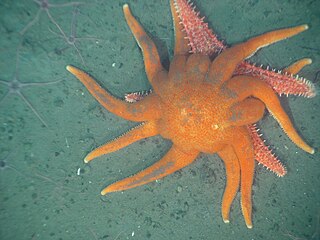
The Valvatida are an order of starfish in the class Asteroidea, which contains 695 species in 172 genera in 17 families.

Astropecten polyacanthus, the sand sifting starfish or comb sea star, is a sea star of the family Astropectinidae. It is the most widespread species in the genus Astropecten, found throughout the Indo-Pacific region. The armspread is up to 20 cm (8 in). The specific epithet "polyacanthus" comes from the Latin meaning "many thorned".
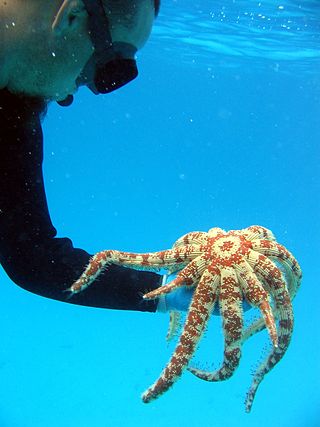
Luidia is a genus of starfish in the family Luidiidae in which it is the only genus. Species of the family have a cosmopolitan distribution.
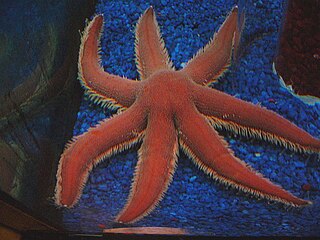
Luidia ciliaris, the seven-armed sea star, is a species of sea star (starfish) in the family Luidiidae. It is found in the eastern Atlantic Ocean and the Mediterranean Sea.

Astropecten irregularis is a sea star of the family Astropectinidae. Common names include Sand sea star.
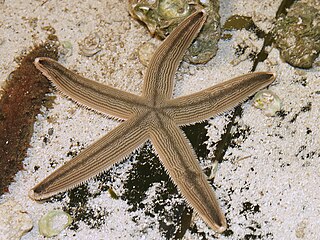
Luidia clathrata is a tropical species of starfish in the family Luidiidae. It is variously known as the slender-armed starfish, the gray sea star, or the lined sea star. It is found in the western Atlantic Ocean.
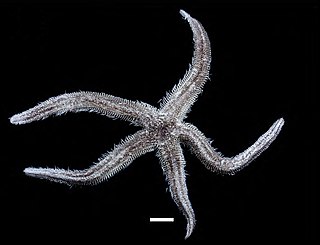
Luidia superba is a tropical species of starfish in the family Luidiidae. A single specimen was found off the Pacific coast of Colombia in 1888; the species has since been found in the Galapagos Islands. It is endemic to this area and has not been recorded elsewhere.
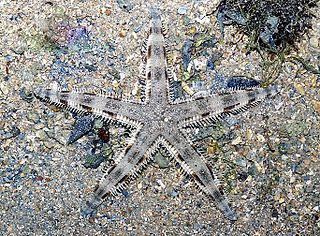
Archaster typicus is a species of starfish in the family Archasteridae. It is commonly known as the sand star or the sand sifting star but these names are also applied to starfish in the genus Astropecten. It is found in shallow waters in the Indo-Pacific region.

Luidia senegalensis, the nine-armed sea star, is a tropical species of starfish in the family Luidiidae found in the western Atlantic Ocean.

Luidia foliolata, the sand star, is a species of starfish in the family Luidiidae found in the northeastern Pacific Ocean on sandy and muddy seabeds at depths to about 600 m (2,000 ft).

Ophiura albida is a species of brittle star in the order Ophiurida. It is typically found on the seabed in the north eastern Atlantic Ocean and in the Mediterranean Sea and is sometimes known as the serpent's table brittle star.

The spiny sand seastar is a species of starfish in the family Luidiidae. It is found in shallow parts of the China Sea and in the vicinity of the Korean archipelago. The tissues of this starfish have been found to contain several secondary metabolites with medicinal potential.

Astropecten scoparius is a sea star in the family Astropectinidae. It is found in shallow water in the East China Sea and around the coasts of Japan. It is a grey starfish and each of its five arms has a narrow pale margin. It burrows in the muddy sediments on the seabed and feeds on molluscs.

Luidia australiae, the southern sand star, is a species of starfish in the family Luidiidae. It is found in the Pacific Ocean around Australia and New Zealand.
Trophodiscus almus is a species of starfish in the family Astropectinidae. It is found in fairly deep waters in the Sea of Okhotsk, the Sea of Japan and around the Japanese island of Hokkaido. It is very unusual among starfish in that it broods its young on its upper surface. Its common name in Japanese is "Komochi-momiji".
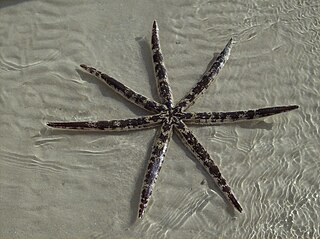
Luidia maculata is a species of starfish in the family Luidiidae in the order Paxillosida. It is native to the Indo-Pacific region. It is commonly known as the eight-armed sea star because, although the number of arms varies from five to nine, eight arms seems to be the most common.

Stichaster striatus, the common light striated star, is a species of starfish in the family Stichasteridae, found in the southeastern Pacific Ocean. It was first described by the German zoologists Johannes Peter Müller and Franz Hermann Troschel in 1840.
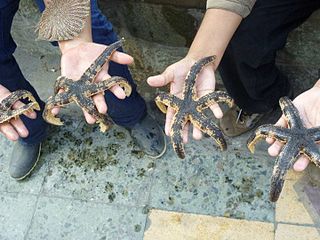
Luidia magellanica is a species of starfish in the family Luidiidae. It is found in the southeastern Pacific Ocean on the coast of South America.

Luidia savignyi is a species of starfish belonging to the family Luidiidae. The species is found in the tropical and subtropical Indo-Pacific region. It is a large starfish and preys on other echinoderms.




















